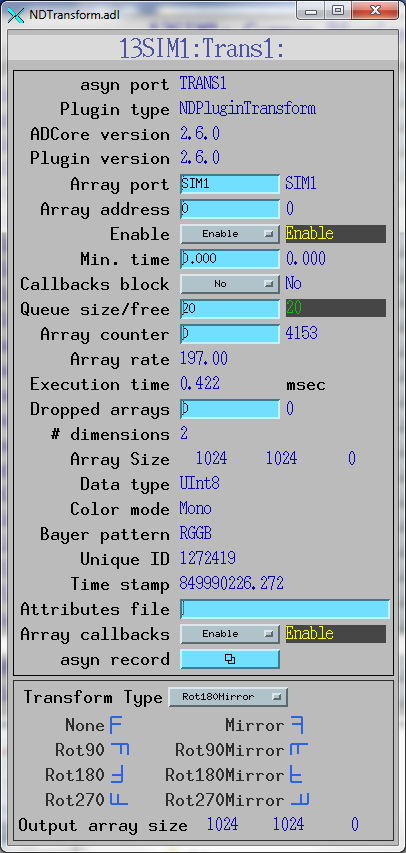NDPluginTransform
- authors:
Christian Roehrig, Mark Rivers, John Hammonds
- affiliation:
Argonne National Laboratory
Overview
This plugin provides 8 choices for image transforms that involve rotations by multiples of 90 degrees and mirror reflections about the central vertical line of the image. The plugin supports only 2-D monochrome and color images (RGB1, RGB2, and RGB3).
NDPluginTransform inherits from NDPluginDriver. The NDPluginTransform class documentation describes this class in detail.
NDPluginTransform.h defines the following parameters. It also implements
all of the standard plugin parameters from
NDPluginDriver. The EPICS database
NDransform.template provide access to these parameters, listed in the
following table.
Parameter Definitions in NDPluginTransform.h and EPICS Record Definitions in NDTransform.template |
||||||
|---|---|---|---|---|---|---|
Parameter index variable |
asyn interface |
Access |
Description |
drvInfo string |
EPICS record name |
EPICS record type |
NDPluginTransformType |
asynInt32 |
r/w |
Type of transform. Choices are: |
TRANSFORM_TYPE |
$(P)$(R)Type |
mbbo |
Configuration
The NDPluginTransform plugin is created with the NDTransformConfigure
command, either from C/C++ or from the EPICS IOC shell.
NDTransformConfigure(const char *portName, int queueSize, int blockingCallbacks,
const char *NDArrayPort, int NDArrayAddr,
int maxBuffers, size_t maxMemory,
int priority, int stackSize)
For details on the meaning of the parameters to this function refer to the detailed documentation on the NDTransformConfigure function in the NDPluginROI.cpp documentation and in the documentation for the constructor for the NDPluginTransform class.
Screen shots
The following MEDM screen provides access to the parameters in
NDPluginDriver.h and NDPluginTransform.h through records in
NDPluginBase.template and NDTransform.template. The orientation of the
letter F on the screen shows what each transform type does.

Performance
The following is a measurement of the performance of the NDPluginTransform plugin in release R2-1. The measurements were done with the simDetector on an 8-core Linux machine. All plugins except the NDPluginTransform plugin were disabled. The simDetector was generating about 680 frames/s in mono mode and about 190 frames/s in RGB1 mode. The plugin was thus always dropping frames except when the transformation was None in mono and RGB1 mode, and when the transformation was Rot180Mirror in mono mode.
Performance (frames/s) |
|||
|---|---|---|---|
Dimensions |
Transformation |
8-bit Mono |
8-bit RGB1 |
1024 x 1024 |
None |
680 |
190 |
1024 x 1024 |
Rot90 |
115 |
40 |
1024 x 1024 |
Rot180 |
145 |
52 |
1024 x 1024 |
Rot270 |
105 |
41 |
1024 x 1024 |
Mirror |
152 |
56 |
1024 x 1024 |
Rot90Mirror |
116 |
40 |
1024 x 1024 |
Rot180Mirror |
680 |
75 |
1024 x 1024 |
Rot270Mirror |
111 |
41 |
Note that this performance with ADCore R2-1 and later is dramatically improved from R2-0 and earlier. For example, in R2-0 with 1024 x 1024 8-bit mono images the frame rate for all transformations (including None) was only 8 frames/s. With 8-bit RGB1 the frame rate for all transformations was only 3 frames/s. Thus, R2-1 improves the performance by a factor of 13-85 compared to previous versions.